The GIGABYTE Z390 Aorus Pro WIFI Motherboard Review: A Sturdy $200 Surprise
by Gavin Bonshor on April 12, 2019 10:00 AM ESTVisual Inspection
The GIGABYTE Z390 Aorus Pro WIFI positions itself in a highly contested price bracket at $200 and looks to stand out as one of the most unique styled ATX sized Z390 motherboards. It has stiff competition from models such as the ASRock Z390 Phantom Gaming 6 ($196), the ASUS ROG Strix Z390-H Gaming ($190) and the MSI MPG Z390 Gaming Pro Carbon ($200).
Nestled onto a fully black PCB is a nicely contrasting Aorus Falcon logo coming from the bottom left and the GIGABYTE Z390 Aorus Pro WIFI uses a black and silver heatsinks with a black glossy plastic rear panel cover. An Aorus Falcon is subtly carved into the chipset heatsink which doubles up as one of the customizable RGB LED zones along with others in the audio PCB separation line, the Aorus logo in the rear panel cover and in-between the RAM slots. Users looking to expand upon this can do so via the two 5050 RGB and two addressable RGB headers. For the price, the GIGABYTE Z390 Aorus Pro WIFI offers eight 4-pin headers which cement it as one of the most comprehensive Z390 boards for cooling, let alone for the price. These are divided into four different areas which include one for a CPU fan, two water cooling pumps, a water cooling fan and four system fans.
On the memory front, the GIGABYTE Z390 Aorus Pro WIFI has support for both ECC and non-ECC unbuffered memory with a maximum supported capacity of up to 128 GB across four available slots; this is due to official support for the new 32 GB UDIMM DDR4 modules. For users looking to use high-spec DDR4 memory, the Z390 Aorus Pro WIFI also supports up to DDR4-4266 memory in dual-channel with XMP 2.0 profiles.
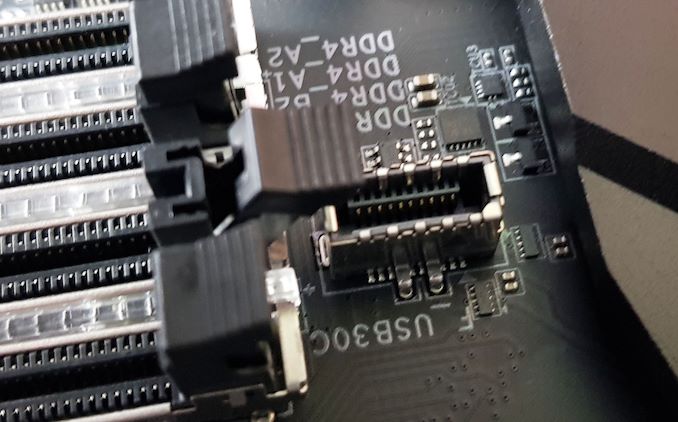
The front panel USB Type-C header is too close to the RAM slot clasp
Just like we found in our GIGABYTE Z390 Aorus Master review, the front panel USB 3.1 G1 Type-C header sits very close to one of the RAM slot clasps and could potentially make installing and uninstalling memory an issue if the header is in use. The quick fix would be to unplug the header temporarily while installing the memory, but if everything required a quick fix, then it wouldn't exactly be convenient and as a result, it's a negative that needed to be mentioned. For reference, the GIGABYTE Z390 Aorus Master which costs $290 has seven.
Located on the southern area of the board are three full-length PCIe 3.0 slots with the first and second slot getting a treatment of metal slot protection. These slots are run from the CPU and support x16 or x8/x8, while the third slot remains bare and is limited to just x4 from the chipset. This means that two-way SLI and up to three-way CrossFire multi-graphics card configurations can be used. In addition to the full-length slots, there are three PCIe 3.0 x1 slots present. Sandwiched in between the boards PCIe slots are two M.2 slots which each slot featuring its own M.2 heatsink. The top M.2 slot supports M.2 22110 drives whereas the bottom M.2 slot has support for up to M.2 2280. There is also a total of six SATA ports which allow for RAID 0, 1, 5 and 10 arrays to be used.
| GIGABYTE Z390 Aorus Pro WIFI PCIe Layout | |||
| Number of Installed PCIe Cards on CPU |
PCIe_1 | PCIe_2 | PCIe_3 |
| x1 | x16 | - | - |
| x2 | x8 | x8 | - |
| x3 | x8 | x8 | x4 |
Underneath the rather hefty L shaped heatsink, which is fused together with a heat pipe, is a large power plane with a 12+1 phase power delivery. The power delivery is regulated by an Intersil ISL69138 7-channel PWM controller with a total of twelve Vishay SiC634 50 A power stages which are doubled by six Intersil ISL6617 doublers. A single Vishay SiC632 50 A power stage is used for the iGPU which technically speaking means the GIGABYTE Z390 Aorus Pro WIFI is running in a 6+1 configuration. Each of the 50 A power stages gets its own indeterminable inductor which means the CPU V-Core and iGPU sections feature thirteen in total. Providing power to the power delivery is a single 8-pin and 4-pin 12 V connector.
| Z390 Motherboard Power Delivery Comparison | |||||
| Motherboard | Controller | H-Side | L-Side | Chokes | Doubler |
| ASUS ROG Strix Z390-I Gaming | ASP1401CTB (4+2) |
ON NCP302045 (6) |
11 | - | |
| ASRock Z390 Taichi | IR35201 (5+2) |
TI 87350D (12) ON FDPC5939SG (2) |
14 | IR3598 (6) |
|
| ASRock Z390 Taichi Ultimate | IR35201 (5+2) |
TI 87350D (12) ON FDPC5939SG (2) |
14 | IR3598 (6) |
|
| ASRock Z390 Phantom Gaming 9 | IR35201 (5+2) |
TI 87350D (12) ON FDPC5939SG (2) |
14 | IR3598 (6) |
|
| GIGABYTE Z390 Aorus Master | IR35201 (6+2) |
IR3553 (12) |
14 | IR3599 (6) |
|
| GIGABYTE Z390 Aorus Ultra | ISL69138 (6+1) |
SiC634 (12) |
13 | ISL6617A (6) |
|
| GIGABYTE Z390 Aorus Pro WiFi | ISL69138 (6+1) |
SiC634 (12) |
13 | ISL6617A (6) |
|
| GIGABYTE Z390 Aorus Pro | ISL69138 (6+1) |
SiC634 (12) |
13 | ISL6617A (6) |
|
| GIGABYTE Z390 Aorus Elite | ISL69138 (6+1) |
SiC634 (12) |
13 | ISL6617A (6) |
|
| GIGABYTE Z390 I Aorus Pro WiFi | IR35201 (6+2) |
IR3553 (6) |
8 | - | |
| GIGABYTE Z390 Gaming SLI | ISL69138 (5+2) |
PPak (10) |
12 | ISL6617A (5) |
|
| GIGABYTE Z390 Gaming X | ISL69138 (5+2) |
PPak (10) |
12 | ISL6617A (5) |
|
| GIGABYTE Z390 UD | ISL69138 (5+2) |
PPak (10) |
12 | ISL6617A (5) |
|
| MSI MEG Z390 ACE | IR35201 (6+2) |
ON4C029N (12) |
ON4C024N (12) |
13 | IR3598 (6) |
| Supermicro C9Z390-PGW | PXE1610 (6+1) PXM1310 (3+1) |
TDA21232 (6) TDA21240 (2) |
8 | - | |
The boards audio PCB is quite simple and straight forward with an illuminated PCB separation line with the primary focus around the EMI shielded Realtek ALC1220-VB HD audio codec. Complementing this is a total of eleven audio capacitors; seven gold and four WIMA capacitors. Situated next to these are a single front panel audio and S/PDIF header.
The bulk of rear panel connections are made of USB ports There are two USB 3.1 G2 Type-A, one USB 3.1 G2 Type-C, three USB 3.1 G1 Type-A and four USB 2.0 ports. Users have the option to use the included front panel headers with a single USB 3.1 G1 header (two ports), two USB 2.0 headers (four ports) and a single USB 3.1 G2 Type-C header (one port). The Z390 Aorus Pro WIFI benefits from an Intel 9560 2T2R Wave 2 802.11ac Wi-Fi adapter which uses the Z390's CNVi for speeds up to 1.73 Gbps. A single Ethernet port is powered by an Intel I219V 1 GbE NIC, which the five 3.5 mm audio jacks and S/PDIF optical output take direction from the Realtek ALC1220-VB HD audio codec. A single HDMI 1.4 video output is present for users looking to use onboard graphics. More of a design aspect than one of function, the rear panel comes supplied with a pre-attached IO shield.
What’s in the Box
Bundled with the GIGABYTE Z390 Aorus Pro WIFI is plenty for users to sink their teeth into with four RGB LED extensions (one for each header), two M.2 mounting kits, four SATA cables and the usual driver installation disk, and installation manual. A dual band antenna for the Intel 9560 802.11ac also sits within the included accessories bundle. This feels like a good package for the capabilities of the board.
- Four SATA cables (two right-angled, two straight angled)
- Four RGB LED extension cables (two 5050, two addressable)
- Intel 9560 802.11ac Wi-Fi Antenna
- Two M.2 mounting kits with screws
- Instruction manual
- Driver/Utility installation disk
- Quick install guide
- Aorus case badge
- G connector


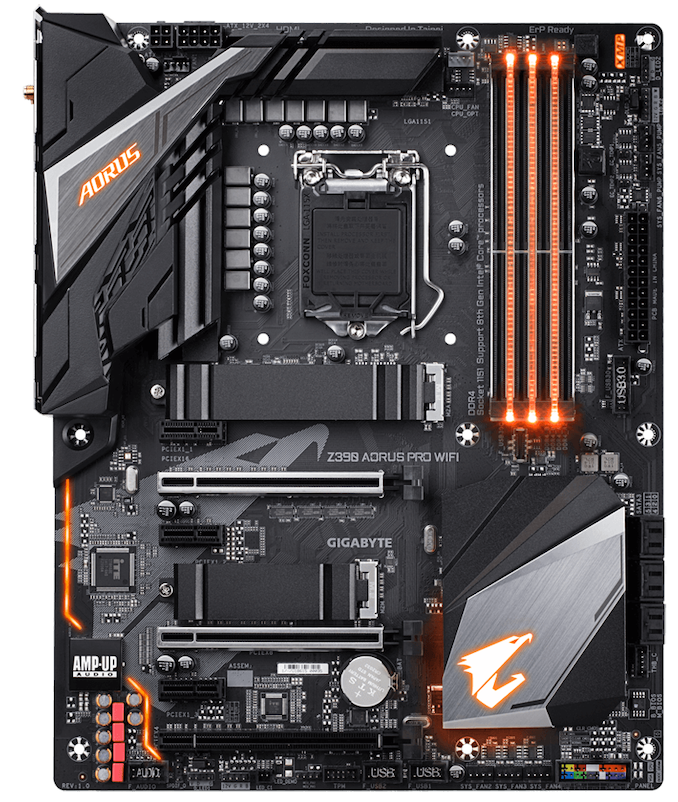
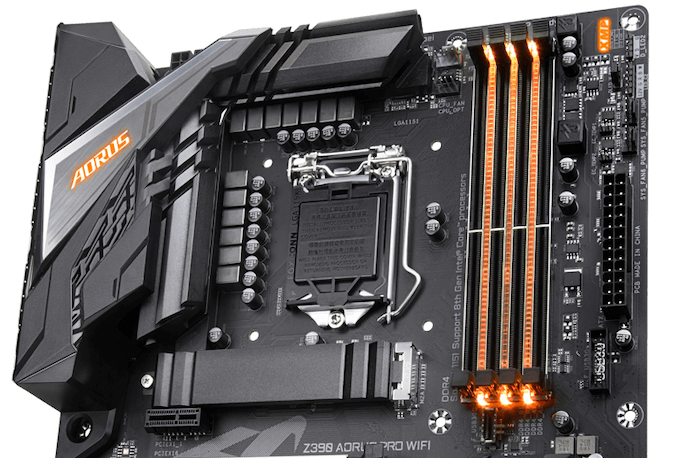
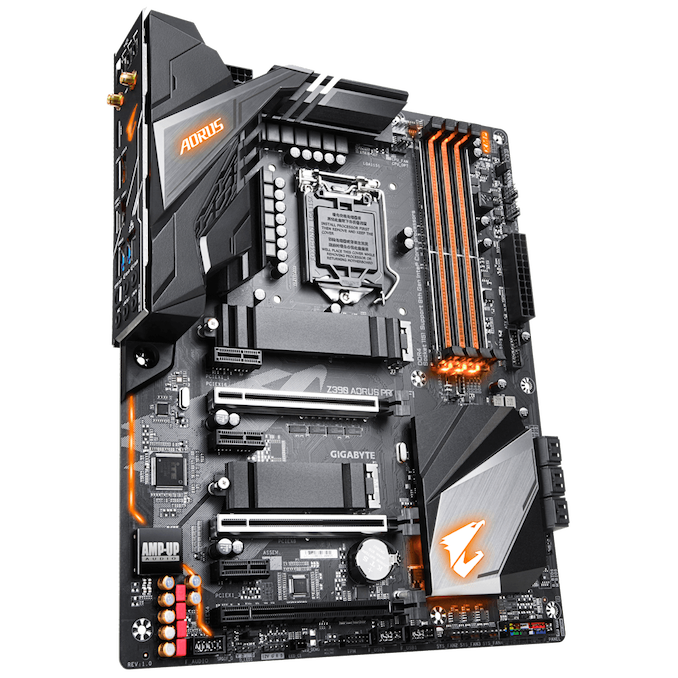
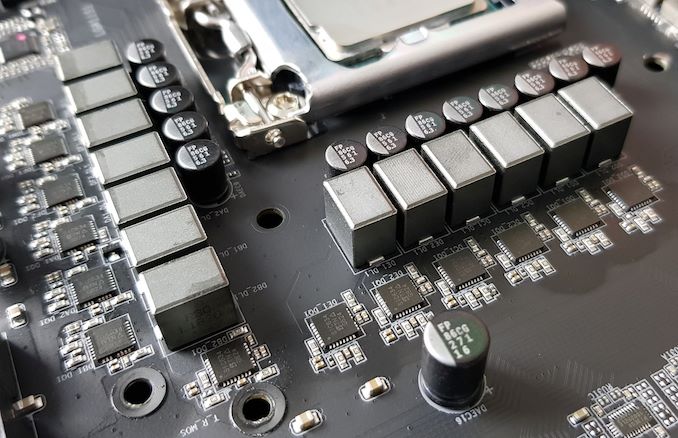
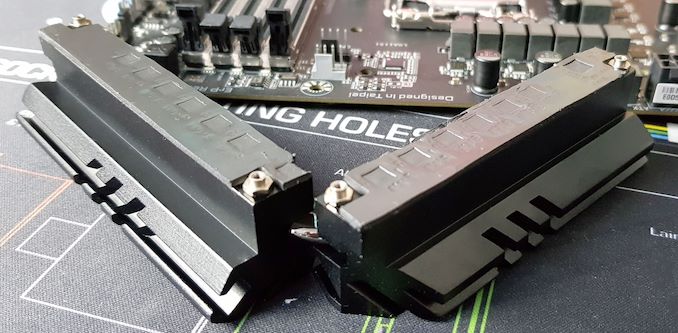
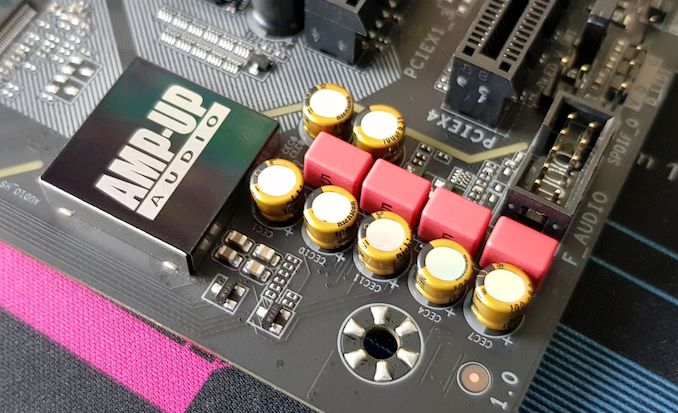

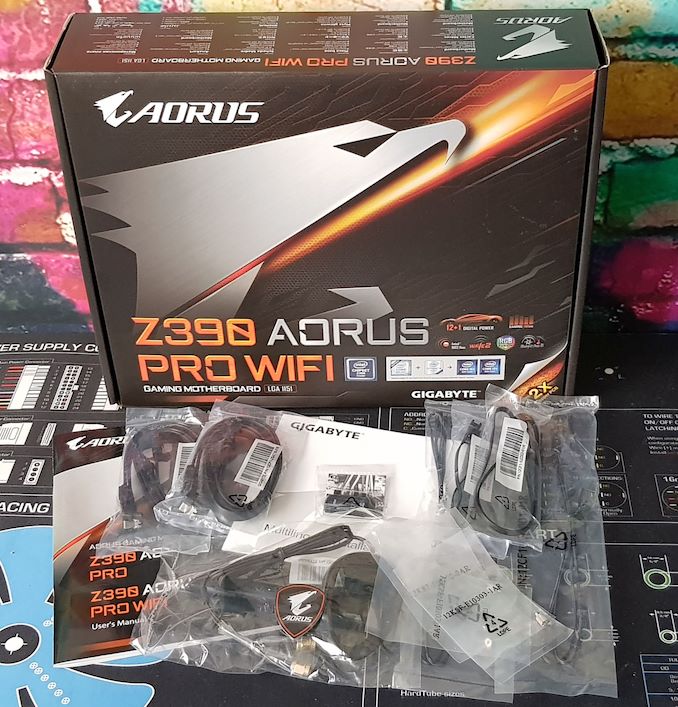








33 Comments
View All Comments
Alistair - Friday, April 12, 2019 - link
The problem I've had with several Z390 boards is their inability to handle the 9900k at full load above 4.5ghz. Prime95 will reduce the clock speed to about 4.5ghz despite settings. It's not just a VRM temp issue causing the downclock. You're better off with an 8700k than a 9900k imo with this board. I wish the 9900k OC was tested with prime95 in the review :)dotes12 - Friday, April 12, 2019 - link
Any version of Prime95 after 26.6 use AVX instead of SSE instructions. Most people overclock their CPU to be stable at the workloads they typically perform, and 100% AVX is not a typical workload for most people. To help people overclock, the Z390 chipset allows the detection of AVX workloads and allow an overclock deduction (AVX Offset) to continue to be stable and not create so much heat. I tried disabling my AVX offset and it would always crash my 9900K running at 5.0 GHz within a couple seconds of starting the Prime95 AVX test.Surfacround - Friday, April 12, 2019 - link
interesting, asus my z390i-gaming and i9-9900k (with evga 750p2 psu and nzxt h41 AIO cooler) can pull 250w running prime95 or y-cruncher...(hwinfo watt readout) (serious heat... 95-100c) but it does not crash...weevilone - Monday, April 15, 2019 - link
So the solution to rigorous AVX workloads on the 9900K is to go with a CPU that uses fewer cores to make your overclock look better? Ok..LoneWolf15 - Sunday, June 2, 2019 - link
Did you turn off AVX tests to run Prime95? AVX testing was added in recent versions, and really raises the temps. Testing for stability, most recommend turning AVX off.I haven't done Prime95, but I'm rock-stable 24/7 for days/weeks of Folding@home running all eight CPU cores of my 9900K to 100% at 4.8GHz using this board.
drexnx - Friday, April 12, 2019 - link
I can never tell if the lower part of the aorus logo is the lower jaw of the bird, or if it's a bird-man hybrid and it's doing a bicep curl.Cellar Door - Friday, April 12, 2019 - link
Neither - its the talon(claw). Just imagine an eagle/falcon swooping down to attack its prey.On a side note - Gigabyte doesn't cheap out on features (wifi, 1220 audio and solid vrm) but I do agree a wonky bios can ruin a positive user experience.
After reading about poor OC bios section - on their b450 and x470 Ryzen boards, in the end I went with Asus, even though I had to pay after %15.
Death666Angel - Friday, April 12, 2019 - link
Seems weird that the talon is pointed the wrong way up? :)I've had pleasureable experiences with Gigabyte during the P55 era and have a nice little parallel port Atom ITX board. I'm currently running an MSI mainboard and have had great AsRock ones.
MDD1963 - Saturday, April 13, 2019 - link
So the talon hand is doing a biceps curl/posing routine? :)29a - Friday, April 12, 2019 - link
birdman for sure